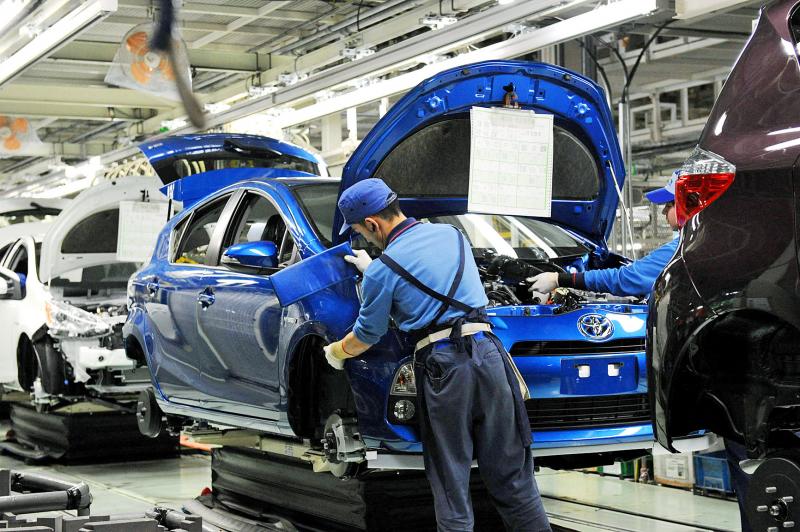Toyota Motor Corp trimmed its production outlook by about 3 percent to 9 million units from 9.3 million for the fiscal year ending March, blaming the spread of COVID-19 in Southeast Asia.
The world’s No. 1 automaker is adjusting production this month and reviewing plans for next month, while sticking to its forecast for operating profit of ¥2.5 trillion (US$22.7 billion) for this fiscal year.
Toyota last month warned of cuts due to the semiconductor and parts shortages as manufacturers were hit by COVID-19. Still, the move shows how even Toyota, having weathered the shortages well compared with peers, is vulnerable to the same constraints hurting the industry.

Photo: AFP
“Key reasons for the production adjustment include a decline in operations at several local suppliers due to the prolonged spread of COVID-19 in Southeast Asia and the impact of tighter semiconductor supplies,” Toyota said in a statement. “Although the outlook for November and beyond is unclear, current demand remains very strong.”
Japanese automakers have over the past decade invested heavily in Southeast Asia, a source of cheap labor and a supplement to their China operations amid trade tensions between that country and the US. Thailand is a major production hub for Toyota, Mitsubishi Motors Corp, Honda Motor Co and Nissan Motor Co.
Toyota said it is cutting this month’s output by 70,000 units and next month’s by 330,000. The company’s shares closed up 0.6 percent before the announcement.
The company is seeking to secure substitute parts to meet inventory-depleting global demand for vehicles. Automakers globally have lost revenue because shortages have slammed output. India’s largest automaker by deliveries, Maruti Suzuki India Ltd, said volume would likely drop to about 40 percent of normal last month. In Japan, Suzuki Motor Corp is cutting vehicle production by 20 percent this month, while in Europe, Renault SA plans to halt assembly plants in Spain for as long as 61 days before the end of the year.
“The spread of COVID-19 infections remains unpredictable, making it difficult to maintain operations due to lockdowns at various locations, and we are working to transfer production to other regions,” Toyota said.

China’s Huawei Technologies Co (華為) plans to start mass-producing its most advanced artificial intelligence (AI) chip in the first quarter of next year, even as it struggles to make enough chips due to US restrictions, two people familiar with the matter said. The telecoms conglomerate has sent samples of the Ascend 910C — its newest chip, meant to rival those made by US chipmaker Nvidia Corp — to some technology firms and started taking orders, the sources told Reuters. The 910C is being made by top Chinese contract chipmaker Semiconductor Manufacturing International Corp (SMIC, 中芯) on its N+2 process, but a lack

TECH BOOST: New TSMC wafer fabs in Arizona are to dramatically improve US advanced chip production, a report by market research firm TrendForce said With Taiwan Semiconductor Manufacturing Co (TSMC, 台積電) pouring large funds into Arizona, the US is expected to see an improvement in its status to become the second-largest maker of advanced semiconductors in 2027, Taipei-based market researcher TrendForce Corp (集邦科技) said in a report last week. TrendForce estimates the US would account for a 21 percent share in the global advanced integrated circuit (IC) production market by 2027, sharply up from the current 9 percent, as TSMC is investing US$65 billion to build three wafer fabs in Arizona, the report said. TrendForce defined the advanced chipmaking processes as the 7-nanometer process or more

NVIDIA PLATFORM: Hon Hai’s Mexican facility is to begin production early next year and a Taiwan site is to enter production next month, Nvidia wrote on its blog Hon Hai Precision Industry Co (鴻海精密), the world’s biggest electronics manufacturer, yesterday said it is expanding production capacity of artificial intelligence (AI) servers based on Nvidia Corp’s Blackwell chips in Taiwan, the US and Mexico to cope with rising demand. Hon Hai’s new AI-enabled factories are to use Nvidia’s Omnivores platform to create 3D digital twins to plan and simulate automated production lines at a factory in Hsinchu, the company said in a statement. Nvidia’s Omnivores platform is for developing industrial AI simulation applications and helps bring facilities online faster. Hon Hai’s Mexican facility is to begin production early next year and the

Who would not want a social media audience that grows without new content? During the three years she paused production of her short do-it-yourself (DIY) farmer’s lifestyle videos, Chinese vlogger Li Ziqi (李子柒), 34, has seen her YouTube subscribers increase to 20.2 million from about 14 million. While YouTube is banned in China, her fan base there — although not the size of YouTube’s MrBeast, who has 330 million subscribers — is close to 100 million across the country’s social media platforms Douyin (抖音), Sina Weibo (新浪微博) and Xiaohongshu (小紅書). When Li finally released new videos last week — ending what has